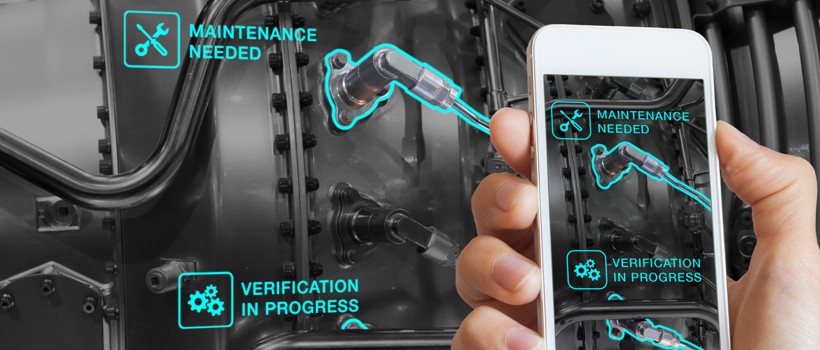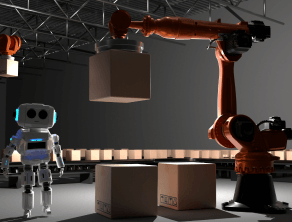Current State of Digital Transformation in Manufacturing: Driving Factors, Opportunities and Learnings
Table of Contents
- Industry 1.0 to Industry 4.0
- Manufacturing through uncertainty: Growth drivers
- Riding the tide of Opportunities: How manufacturing companies are using Industry 4.0 technologies
- Takeaways: What we can learn from the current state of digital manufacturing
- Conclusion
Industry 1.0 to Industry 4.0
We’re in the middle of the fourth industrial revolution where labours on factory shop floors have been replaced with smart manufacturing facilities, where tech-savvy workers leverage sophisticated technologies to create the products of the future. Unlike the previous industrial revolutions, each being a breakthrough in their time, of course, this one goes far beyond manufacturing- it marks a shift from physical to software, from processes and functions to data. It embeds smart and connected technologies to your legacy production units in order to create a manufacturing ecosystem that is interconnected, able to communicate, and can analyze real-time data to drive intelligence back into the system. It is predicted that by 2020, 60% of the top manufacturers will rely on industry 4.0 technologies that will support as much as 30% of their overall revenue.
Manufacturing through uncertainty: Growth drivers
We live in a VUCA world that presents many challenges to the manufacturing industry and other industries as well. To counter these forces of volatility, uncertainty, complexity and ambiguity, innovators have sought solutions by adopting the latest technologies, thereby converting much of the challenges into opportunities. While several driving forces of digital transformation in the manufacturing industry are relatively similar to those in other industries, we’ll discuss the ones more specific to the manufacturing industry.
-Geopolitics:
Manufacturing industry is facing the heat from the growing uncertainty and unpredictability in global politics and macroeconomics. The protectionist environment in the US with special focus on manufacturing industry, for instance. In other regions similar protectionist risks are present. A Forbes report mentions how the growing divide due to geopolitics is forcing companies to consider other sources and manufacturing options. Similarly, the uncertainties caused by Brexit have created a push for driving Industry 4.0 forward. With Brexit, trading with the EU will be disrupted and become more costly as employing EU nationals would become challenging with the curtail on the free movement of labor. With the drop in the value of currency, exports are likely to get competitive while the cost of importing inputs might rise, thereby impacting the output price. In such a scenario, the need to push to automate processes, save costs and increasing efficiencies becomes higher.
-Consumer preferences:
Consumers don’t see manufacturers, brands, products, and resellers differently. For them, both product and brand experience are the same. They wouldn’t care if their product failed because of a broken part that was manufactured by an outsourced manufacturer. As a result, the rapidly evolving consumer expectations such as quick delivery, affordable, high quality and customized products are directly impacting the entire manufacturing supply chain. Even manufacturers share interdependency, therefore, even if some manufacturers don’t produce consumer goods, they too, are impacted by changing consumer preferences. This leads us to the need for evolution in logistics that can accommodate the dynamic requirements in manufacturing better.
-Improving profitability through cost-saving:
With demand for consumer as well as industrial products being uncertain, the profitability of the manufacturing industry is constantly in a state of flux. To maintain their profitability, manufacturers need to stop relying on revenue from selling products alone and focus on bringing down the costs. The production costs can be brought down by leveraging latest technologies to increase operational efficiencies, reduce operating costs and improve quality control, while also reducing regulatory compliance costs.
-Servitization of manufacturing:
Manufacturers are under pressure to cut costs and are being pushed to deliver products faster, for a lesser price. Not only do they need to leverage technology to enhance operational efficiencies and support lean production initiatives, but they also need to shift to a more customer-centric approach and explore new service-based business models to build value and generate new revenue streams. Microsoft’s 2019 Manufacturing Trends Report mentions that until now, contract manufacturing has always been a service, but digitization has changed the way products are designed and the way manufacturers produce those products. These changes have led to the development of Manufacturing as a Service, where businesses can use a shared network of manufacturing infrastructure- from machines and maintenance to software and networking.
Riding the tide of Opportunities: How manufacturing companies are using Industry 4.0 technologies
In this era of Industry 4.0, machinery is equipped with intelligent sensors to collect extensive, real-time data; artificial intelligence allows superhuman efficiency and quality assurance; blockchain transactions create trust with transparency and security; and edge computing guarantees uninterrupted connectivity. Manufacturers are leveraging these technologies and creating a tide of opportunities. It’s safe to say that if adopted correctly, the technologies prevalent in the current industrial revolution guarantee:
- Economic gains, such as increased revenues and lower operating costs
- Consistent productivity and output; more reliable and better quality products
- Sustainable and Energy-efficient production environment
- Optimal use of human and material resources
- More open innovation systems
- Changes in the organization culture, with remote, flexible and on-demand work becoming a standard and much more!
Let’s have a look at how manufacturers worldwide have used these technologies to their advantage and become trendsetters in Industry 4.0.
-
- IoT for inventory and supply chain managementBJC HealthCare, a healthcare service provider that operates 15 hospitals in Missouri and Illinois, deployed RFID technology to track and manage thousands of medical supplies. Previously, the process of tracking inventory involved a lot of manual labor. In some cases, products’ expiration dates needed to be closely monitored and the loss of stock lead to a lot of time spent on conducting inventory checks. After implementing RFID, BJC has been able to reduce the stock kept onsite at each facility by 23%. The company predicts that it will achieve savings of almost $5 million annually, once RFID tagging is fully implemented.
- Big Data analytics for optimizing production processesBosch Automotive Diesel System factory in China embedded sensors into the factory’s machines to collect data about the machines’ performance. Once the data is collected, data analytics tools process the data in real-time and alert workers if there are any bottlenecks in the production. This approach has helped Bosch to predict equipment failures, enabled the factory to schedule maintenance operations before any failures occur, and has contributed to more than 10% output increase in certain areas while improving delivery and customer satisfaction.
- Enabling connected cars through CloudVolkswagen, in collaboration with Microsoft, is set to develop a cloud network called “Volkswagen Automotive Cloud”. The technology, scheduled for 2020, will offer a range of features such as a digital assistant, predictive maintenance service, media streaming and updates. As the automotive industry is moving towards developing advanced autonomous and vehicles, makers need an effective way to manage and transmit large amounts of data to their vehicles. Cloud-based storage and communication platform serves as the most effective way to meet this requirement of automakers.
- Augmented reality for increased efficiencyGeneral Electric Aviation used AR glasses to help engineers manufacture jet engines. By using AR technology, workers received instant feedback on whether they were accurately tightening and sealing nuts in the engine. This resulted in significant time savings, with increased efficiencies of up to 11%. It was also effective in enhancing quality control and safety standards. AR headsets were also used to give factory workers access to additional visualized information, such as machinery performance statistics, product assembly supervision and parts of potential malfunction.
Takeaways: What we can learn from the current state of digital manufacturing
If we are to mention a key takeaway from the current state of digital transformation in manufacturing, it would be that manufacturers should focus on solutions, not technologies. It is essential to note that new technologies do not guarantee solving a problem and they aren’t helpful unless they create some value. Simply put, if you plan to make the maximum out of digital manufacturing technologies, you must:
-
-
- Identify the problem that you intend to solve. Do you want to reduce wastage or improve accuracy? Do you want to save time by automating routine activities or is your focus on reducing maintenance downtime?
- Decide upon the area where you want to solve problems and set key parameters to measure performance before and after implementation of relevant technology.
- Based on information gathered from the above two points, decide on which digital technology has the capability to solve your problem optimally.
- Test on a single production asset and scale up gradually, start collecting and analyzing data and use the insights derived into decision-making process.
- Integrate it in your ecosystem, move applications and data to the cloud, utilize data, share knowledge with stakeholders, and explore potential avenues to further the quality and scope of your products and services.
- Partner with experts in digital technology and services such as [x]cube LABS and leverage their expertise to be aware of the latest solutions and how to implement them.
-
Conclusion
It’s clear that despite the rising challenges in manufacturing industries, manufacturers are using technologies such as advanced analytics, automation, AR and more in the mix, to convert them into opportunities. The overall aim of manufacturing in current scenario is to increase productivity, lower costs and reduce errors, and digital manufacturing is making it possible. Although the manufacturing industry has been slow off the mark with digital disruption, examples of innovative companies mentioned in this article show that change can be managed effectively and used to gain business advantage.
The digital manufacturing market is expected to reach USD 299.19 billion by 2023, at a CAGR of 11.9% from 2018 to 2023. The growth statistics shows that the tides are in favor of digitizing manufacturing industry, it is up to manufacturers to make it possible to use the driving factors to their advantage and get the maximum out of it.
![Blog-[x]cube LABS](https://d6fiz9tmzg8gn.cloudfront.net/wp-content/uploads/2016/06/blog_banner.jpg)








